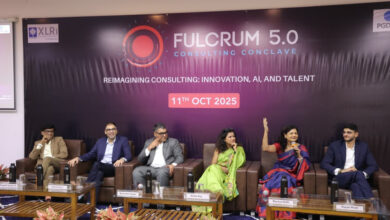Aludecor Announces Entry Into Metal Ceilings With Fully In-House, Coil Coating-To-Ceiling Manufacturing

Kolkata, (West Bengal) [India], August 18, 2025: Aludecor, one of India’s most celebrated names in architectural cladding and façades, has announced its bold entry into the metal ceilings market, unveiling a first-of-its-kind backward integration from coil coating to finished ceiling systems. With this move, the company has extended its leadership in façades to interiors, becoming one of the very few Indian brands to offer a seamless façade-to-ceiling solution for architects, developers, and corporates.
The new ceiling line joins Aludecor’s established portfolio of Metal Composite Panels, Honeycomb Panels, and Alubreeze Sun-Louvers, creating what the brand calls a “full-stack envelope-to-interior ecosystem”—one that places quality, finish, and performance at the heart of modern construction.
With three advanced manufacturing units in Haridwar and one of India’s largest in-house coil-coating capacities, Aludecor’s ceiling panels and planks will be crafted on the same roller-coating lines used for its world-class façade systems. This ensures flawless colour consistency between façades, soffits, and ceilings, ensuring superior surface finish and durability, and faster, made-in-India supply chains that reduce import dependency.
The company’s strategic entry comes at a time when the global metal ceilings market, valued at USD 8.55 billion in 2023, is projected to expand to USD 14.68 billion by 2032. In India, specifications have long been dominated by multinational players, an imbalance Aludecor now intends to correct through domestic innovation, cost efficiency, and service reliability.
Ashok Kumar Bhaiya, Founder and CMD, Aludecor, positioned the launch as a transformative step and stated “India’s building boom deserves globally benchmarked products that are also proudly made in India. By bringing coil-to-ceiling manufacturing under one roof, we eliminate import friction, compress lead times, and give architects one harmonized palette from façade to interior. This is not just a line extension, it’s a strategic backbone for the next decade of Indian real estate.”
Further augmented by Saurav Kabra, Director, Aludecor, “Specifiers have long demanded colour-matched façades and ceilings, reliable acoustic performance, and faster project servicing. With our backward integration and national sales network, Aludecor will now compete head-on with global incumbents, by delivering speed, consistency, and value while aligning with India’s green-building momentum.”
Aludecor’s Metal ceiling Panels are roller-coated in-house, ensuring exact colour and finish matches with ACP/MCP façades and soffits vital for corporate rollouts, tech campuses, healthcare, and transit hubs. With perforations and acoustic backers, Aludecor ceilings can meet high NRC ratings, offering solutions tailored for offices, retail, education, and healthcare segments where global leaders have historically set the benchmarks. Modular ceiling systems are designed for rapid installation, convenient access, and long-term serviceability supported by Aludecor’s pan-India technical teams.
The launch follows the July debut of Alubreeze, India’s first home-grown, roller-coated metal sun-louver system, available in preset angles of 30°, 45°, and 90°. External research shows that optimized shading can reduce building operational energy significantly, making it a critical lever for India’s net-zero ambitions.
Aludecor’s proven track record in fire-retardant ACP Sheets underscores the same rigor applied to its new ceiling systems. Its Firewall range holds Factory Production Control (FPC) certification from Emirates Safety Laboratory (ESL), Dubai, covering EN 13501-1 classifications A2-s1,d0 and B-s1,d0—international benchmarks that reflect the company’s commitment to stringent quality and safety.
About Aludecor:
Founded in 2004 and headquartered in Kolkata, Aludecor is one of India’s leading manufacturers of Aluminium Composite and Metal Composite Panels, with three Haridwar units delivering 9.6 million sq. m annual lamination capacity. Its portfolio includes ACPs and Firewall Nexcomb Honeycomb Panels, Pre-coated coils, Alubreeze metal-louvers, and now Metal Ceilings.




